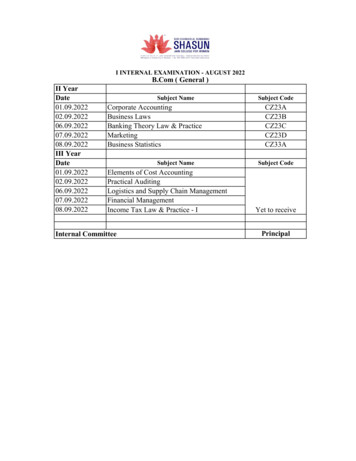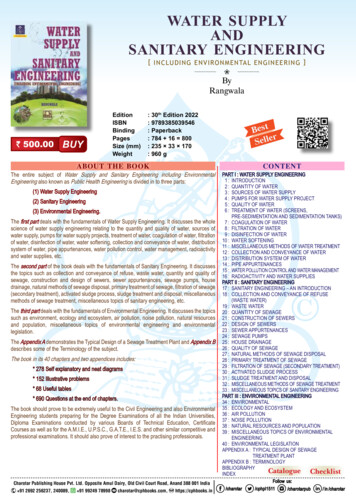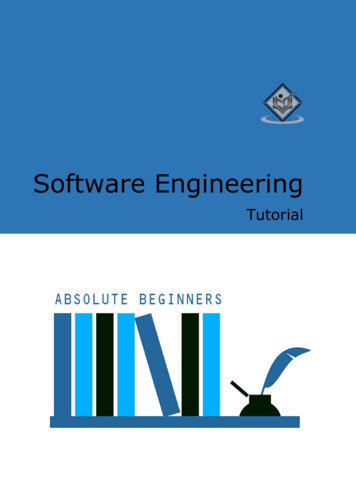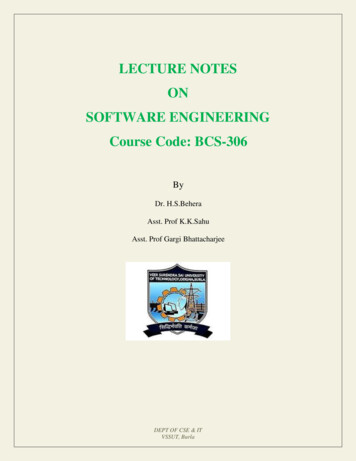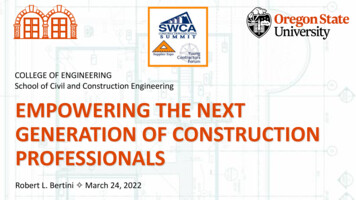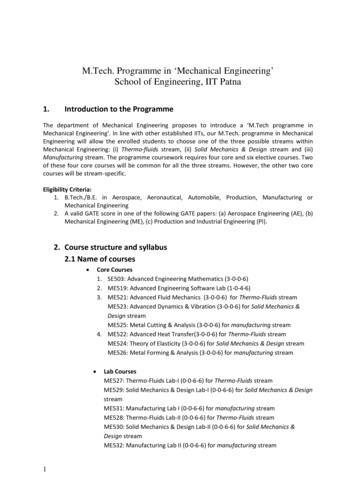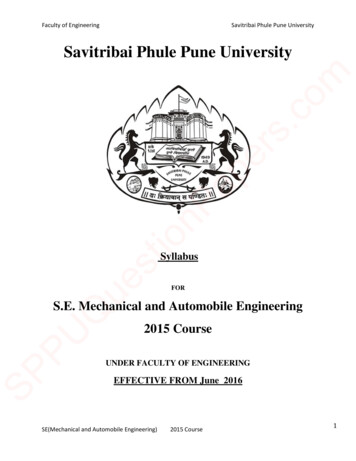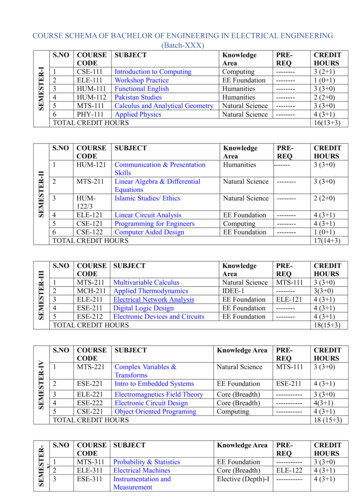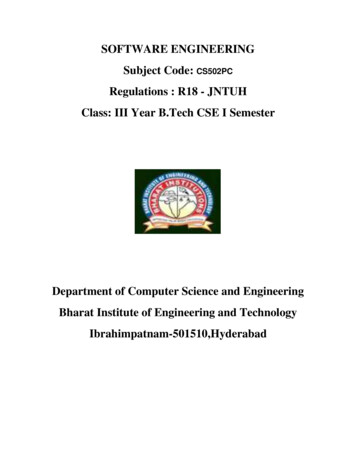
Transcription
SOFTWARE ENGINEERINGSubject Code: CS502PCRegulations : R18 - JNTUHClass: III Year B.Tech CSE I SemesterDepartment of Computer Science and EngineeringBharat Institute of Engineering and TechnologyIbrahimpatnam-501510,Hyderabad
SOFTWARE ENGINEERING (CS502PC)B.Tech. III Year I SemCOURSE PLANNERI. COURSE PURPOSE:At the end of the course the student should be in a position to Understanding of different software processes and how to choose between them How to elicit requirements from a client and specify themDesign in the large, including principled choice of software architecture, the use of modulesand interfaces to enable separate development, and design patterns.Understanding good coding practices, including documentation, contracts, regression testsand daily builds.Various quality assurance techniques, including unit testing, functional testing, andautomated analysis toolsII. PRE-REQUISITES:It‟s expected to have basic Programming Skills, Innovative Thinking, and Enthusiasm tolearn Management.III. COURSE OBJECTIVIES:Understand the software process models such as waterfall and evolutionary models.Understand the software requirements and SRS document.Understand the different software architectural styles.Understand the software testing approaches such as unit testing and integration testing.Understand the quality control and how to ensure good quality softwareIV. COURSE COUTCOMES:S. No.Course Outcomes (CO)Knowledge Level(Blooms Level)CO1Identify the minimum requirements for the development ofL1: REMEMBERapplication.CO2Develop and maintain efficient, reliable and cost effectivesoftware solutionsCO3Critically Think and evaluate assumptions and arguments.L6: CREATEL5: EVALUATEV. COURSE CONTENT:UNIT- IIntroduction to Software Engineering: The evolving role of software, Changing Natureof Software, legacy software, Software myths.A Generic view of process: Softwareengineering- A layered technology, a process framework, The Capability Maturity ModelIntegration (CMMI), Process patterns, process assessment, personal and team processmodels.Process models: The waterfall model, Incremental process models, Evolutionaryprocess models, Specialized process models, The Unified process.UNIT- IICSE III Yr- I SEM32
Software Requirements: Functional and non-functional requirements, Userequirements, System requirements, Interface specification, the software requirementsdocument.Requirements engineering process: Feasibility studies, Requirements elicitation and analysis,Requirements validation, Requirements management.System models: Context Models, Behavioral models, Data models, Object models,structured methods.UNIT- IIIDesign Engineering: Design process and Design quality, Design concepts, the designmodel.Creating an architectural design: software architecture, Data design, Architectural stylesand patterns, Architectural Design, conceptual model of UML, basic structural modeling,class diagrams, sequence diagrams, collaboration diagrams, use case diagrams, componentdiagrams.UNIT- IVTesting Strategies: A strategic approach to software testing, test strategies forconventional software, Black-Box and White-Box testing, Validation testing, System testing,the art of Debugging.Product metrics: Software Quality, Metrics for Analysis Model, Metrics for Design Model,Metrics for source code, Metrics for testing, Metrics for maintenance.UNIT- VMetrics for Process and Products: Software measurement, metrics for software quality.Risk management: Reactive Vs proactive risk strategies, software risks, risk identification,risk projection, risk refinement, RMMM, RMMM plan.VI. LESSON PLAN:LecturenoCourse Learning TeachingMethodolo ReferencesOutcomesgiesAble toUNIT1: Introduction to Softwarechalk & talk T1, R2UnderstandEngineeringwhat isThe evolving role of software,chalk & talk T1, R2SoftwareChanging Nature of SoftwareEngineering,legacy software, Software mythsRoles and chalk & talk T1, R2A Generic view of process:Abletypesto ofsoftwareand chalk & talk T1, R2Software engineering- A layeredUnderstandsoftwaretechnologythe layeredA Process frameworkmythstechnology chalk & talk T1, R2of softwareThe Capability Maturity Modelengineering chalk & talk T1, R2Integration (CMMI)and how toProcess patterns, Processdevelop a chalk & talk T1, R2assessmentAbleprocesstoPersonal and team process modelschalk & talk T1, R2framework,understandProcessmodels andpatternsweek Unit no Topics to be covered12134156278CSE III Yr- I SEM33
Process models: The waterfallmodel910Incremental process models3the variouschalk & talksoftwareprocesschalk & talkmodelsT1, R2T1, R211Evolutionary process modelschalk & talkT1, R212Specialized process models, TheUnified processchalk & talkT1, R2BRIDGE CLASS-1MOCK TEST-I13144151617.2185UNIT 2: Software Requirements: Able tochalk & talkFunctional and non-functionalunderstandthe types ofUserrequirementsrequirements, Systemchalk & talksoftwarerequirements, InterfacerequirementsThespecificationsoftware requirementschalk & talkdocumentAble to prepareRequirements engineering process:SRS for the chalk & talkFeasibility studiesdevelopmentRequirements elicitation andofchalk & talkanalysisapplicationRequirements validation,chalk & talkRequirements management19System models: Context Models20Behavioral models21Data models, Object models22Structured methodschalk & talkAble tounderstandchalk & talkthe differentsoftwarechalk & talkarchitecturalstyleschalk & talkT2T2T2T2T2T2T2T2T2T2BRIDGE CLASS 26MID –I EXAMINATIONSUNIT 3: Design Engineering:Design process and DesignqualityDesign concepts, Design model232425263727CSE III Yr- I SEMPattern based software designCreating an architectural design:software architectureData designAble toPPTunderstanddesignPPTprocess,concepts,model and PPTAblepatternsto createPPTthe softwarearchitecturalPPTdesignT1T1T1T1T134
28Architectural styles and patternsPPTAble to createand assess chalk & talkthe softwarearchitectural chalk & talkdesignchalk & talkT129Architectural Design30conceptual model of UMLchalk & talkT1Able to design chalk & talkUMLDiagrams chalk & talkT1chalk & talkT1Able to design chalk & talkUMLDiagrams chalk & talkT1chalk & talkAble tounderstandchalk & talkvarioussoftwareBlack-Box and White-Box testingchalk & talktestingstrategiesValidation testing, System testing,chalk & talkThe art of Debugging.T1Product metrics: Software QualityT1831basic structural modeling32class diagrams33sequence diagrams34collaboration diagramsT1T1T1T1935use case diagrams36component diagrams37ALL Diagrams DocumentsT1BRIDGE CLASS 338UNIT 4: Testing Strategies: Astrategic approach to softwareTesttestingstrategies for conventionalsoftware1039404144211Able tochalk & talkunderstandProduct andMetrics for Design Modelchalk & talkprocessmetricsMetrics for source code, Metrics forchalk & talktesting, Metrics formaintenance.software quality.BRIDGE CLASS-443Metrics for Analysis Model44454647chalk & talk1248CSE III Yr- I SEM5UNIT 5: Metrics for Process andProducts: Softwaremeasurementmetrics for software qualityRisk management IntroductionAble toPPTunderstandvarious RiskPPTstrategies,Riskidentificatio PPTT1T1T1T1T1T1T1T1T135
49Reactive Vs proactive riskstrategies50software risks1351Risk identification52RiskProjection53Risk refinement541455RMMM IntroductionRMMM planII MID EXAMINATIONSn, arePPTqualityassuranceAbleandto how tochalk & talkunderstandperformqualitySoftwarechalk & talkcontrolReviewsand&toAblehowto doFormalensuregood chalk & talkprojecttechnicalqualityplanningreviews andchalk & talksoftwareprojectmanagementT1T1T1T1T1R11R11TEXT BOOKS:Software engineering A practitioner‟s Approach, Roger S Pressman, sixth edition McGraw HillInternational Edition.Software Engineering, Ian Sommerville, seventh edition, Pearson education.REFERENCE BOOKS:Software Engineering, A Precise Approach, PankajJalote, Wiley India, 2010.Software Engineering : A Primer, Waman S Jawadekar, Tata McGraw-Hill, 2008Fundamentals of Software Engineering, Rajib Mall, PHI, 2005Software Engineering, Principles and Practices, Deepak Jain, Oxford University Press.Software Engineering1: Abstraction and modeling, Diner Bjorner, Springer International edition,2006.Software Engineering2: Specification of systems and languages, Diner Bjorner, SpringerInternational edition 2006.Software Engineering Foundations, Yingxu Wang, Auerbach Publications, 2008.Software Engineering Principles and Practice, Hans Van Vliet, 3rd edition, John Wiley &SonsLtd.VII. HOW PROGRAM OUTCOMES ARE ASSESSED:Program Outcomes (POs)PO1PO2PO3Engineering knowledge: Apply the knowledge of mathematics,science, engineering fundamentals, and an engineeringspecialization to the solution of complex engineering problems.Problem analysis: Identify, formulate, review research literature,and analyze complex engineering problems reachingsubstantiated conclusions using first principles of mathematics,natural sciences, andengineeringsciences.Design/developmentof solutions:Designsolutions for complexengineering problems and design system components orprocesses that meet the specified needs with appropriateconsideration for the public health and safety, and the cultural,societal, and environmental considerations.CSE III Yr- I SEMLevel Proficiencyassessed by3Assignments2Assignments2Open endedexperiments /36
PO4PO5PO6PO7PO8Conduct investigations of complex problems: Use research-basedknowledge and research methods including design ofexperiments, analysis and interpretation of data, and synthesisof the information to provide valid conclusions.Modern tool usage: Create, select, and apply appropriatetechniques, resources, and modern engineering and IT toolsincluding prediction and modeling to complex engineeringactivities with an understanding of the limitations.The engineer and society: Apply reasoning informed by thecontextual knowledge to assess societal, health, safety, legal andcultural issues and the consequent responsibilities relevant tothe professional engineering practice.Environment and sustainability: Understand the impact of theprofessional engineering solutions in societal and environmentalcontexts, and demonstrate the knowledge of, and need forsustainabledevelopment.Ethics:Apply ethicalprinciples and commit to professional ethicsand responsibilities and norms of the engineering practice.PO9PO10PO11PO12Individual and team work: Function effectively as an individual,and as a member or leader in diverse teams, and inmultidisciplinary settings.Communication: Communicate effectively on complex engineeringactivities with the engineering community and with society atlarge, such as, being able to comprehend and write effectivereports and design documentation, make effective presentations,and give and receive clear instructions.Project management and finance: Demonstrate knowledge andunderstanding of the engineering and management principlesand apply these to one‟s own work, as a member and leader ina team, to manage projects and in multidisciplinaryenvironments.Life-longlearning: Recognize the need for, and have thepreparation and ability to engage in independent and life- longlearning in the broadest context of technological change.2Open endedexperiments /2Mini Project1--2--1--1--1Seminars / TermPaper---1CompetitiveExaminationsVIII. HOW PROGRAM SPECIFIC OUTCOMES ARE ASSESSED:Program Specific Outcomes (PSO)PSO1PSO2PSO3Foundation of mathematical concepts: To use mathematicalmethodologies to crack problem using suitable mathematicalanalysis, data structure and suitable algorithm.Foundation of Computer System: The ability to interpret thefundamental concepts and methodology of computersystems. Students can understand the functionality ofhardware and software aspects of computer systems.Foundations of Software development: The ability to grasp thesoftware development lifecycle and methodologies ofCSE III Yr- I ssignm37
software systems. Possess competent skills and knowledgeof software design process. Familiarity and practicalproficiency with a broad area of programming concepts andprovide new ideas and innovations towards research.ents,ExamsIX. QUESTION BANK (JNTUH)UNIT ILong Answer QuestionsS.NoQuestionDefine software and explain the various characteristics ofsoftware?Explain software Engineering? Explain the software2engineering layers?Explain in detail the capability Maturity Model Integration3(CMMI)?Describe with the help of the diagram discuss in detail4waterfall model. Give certain reasons for its failure?Explain briefly on (a) the incremental model (b) The RAD5Model?6Explain product and process are related?7Explain personal and team process models?8Explain process frame work activities?Explain and contrast perspective process models and9iterative process models?10Explain about the evolutionary process models?Short Answer Questions1B standKnowledge333Understand3Understand31Define Software EngineeringBloomsCourseTaxonomy OutcomeLevelsUnderstand12Discuss Management MythsUnderstand1345Discuss Practitioners mythsDiscuss Customer mythsAnalyze the changing nature of softwareUnderstandUnderstandKnowledge223S.No QuestionUNIIT IILong Answer QuestionsS.N012QuestionCompare functional requirements with nonfunctionalrequirements?Discuss briefly how requirement validation is done?CSE III Yr- I SEMBloomsCourseTaxonoOutcomymeLevelKnowledge 3Knowledge 338
Discuss your knowledge of how an ATM is used;develop a set of use-cases that could serve as a basis3for understanding the requirements for an ATMUnderstand 3system?Describe four types of non-functional requirements that4may be placed on a system. Give examples of eachUnderstand 3of these types of requirement?Explain how requirements are managed in software5Understand 4project management?6Explain Behavioral models and Data model?Knowledge 47Explain Object models and Context model?Understand 4Explain SRS document and explain along with its8Understand 4contents?Demonstrate class hierarchy for library by using9Understand 4interface specification?10Explain state machine model with a suitable example?Understand 4Short Answer lme1Discuss Functional requirementsUnderstand2Understand2Discuss Non Functional requirements2Understand3Explain about Requirements Gathering.2Understand4Explain about Requirements Analysis1Understand5Explain about Requirements Management.2UNIT IIILong Answer QuestionsS.No123456CSE III Yr- I SEMQuestionDiscuss briefly the following fundamentalconcepts of software design:AbstractionModularityInformation hidingExplain briefly the following:Coupling between the modules,The internal Cohesion of a moduleDiscuss the fundamental principles ofstructured design. Write notes ontransform analysis?Explain software design? Explain data floworiented design?Explain the goals of the user interfacedesign?Discuss briefly about the golden rules 9
the user interface design?Discuss interface design steps in a briefmanner?Explain pattern based software design in adetail manner?Discuss architectural styles and patterns?Describe the way of conducting acomponent level 6666Short Answer QuestionsS.NoQuestion12345Discuss about Design ProcessDiscuss about Design QualityDefine a Design ModelDiscuss Design StepsDiscuss about Component Level DesignUNIT IVLong Answer QuestionsS.N QuestionoExplain about the importance of test strategies1for conventional software?Discuss and Compare black box testing with2white box testing?Compare validation testing and system testing?3Discuss software quality factors and quality4metrics ? Discuss their relative importance?Explain validation test and verification test? Who5will involve in this testing? Explain withsuitable example?Explain about Metrics for maintenance?6Explain strategic approach to software testing78Demonstrate art of debuggingDiscuss a framework for product metrics9List the metrics for the design model10Short Answer QuestionsS.NQuestion012Define Validation Testing and when it will beperformed.Define System TestingCSE III Yr- I edgeUnderstand77777BloomsTaxonomy LevelCourseOutcomeAnalyze3Apply340
345Define DebuggingDefine Software QualityDefine White-box nomy dge9KnowledgeUnderstand99UNIT VLong Answer QuestionsS.NQuestiono12345678910What is software risks?Elaborate the concepts ofRisk management Reactive vs Proactive Riskstrategies?Explain about RMMM Plan?Explain about Quality concepts and Qualityassurance?Explain about formal technical reviews?Explain in detail ISO 9000 quality standards?Briefly explain about formal approaches to SQAand statistical SQA?Explain risk projection in detail?Explain seven principals of risk management bydeveloping a risk table?Explain six sigma for software engineering?Explain quality management with their terms?Short Answer QuestionsSNoQuestion12345Discuss about Software ReviewsDiscuss about ISO 9000 Quality StandardsDefine about Software Quality AssuranceDiscuss about RMMMDefine the Risk Projection andUnderstandAnalyzeCourseOutcomes42223X. OBJECTIVE QUESTIONS:FILL IN THE BLANKS:UNIT-1is a collection of programs written to service other programs.Answer :.System softwareWater fall model is sometimes called asAnswer :.classical life cycle modelmodel is suitable for project requiring shorter development times .Answer :.RAD modelSpiral Model was developed byAnswer :.Berry BohemCMMI stands forCSE III Yr- I SEM41
Answe r:.Capability Maturity Model Integration.Phases in Unified Process areAnswer :.Inception Elaboration Conception Transitionis a process model that removes defects before they can precipitateserious hazards.Answer :.Cleanroom software engineeringThe quick design of a software that is visible to end users leads to process modelAnswer :prototypemodels is not suitable for accommodating any change?Answer :.Waterfall ModelThe -is a result of combination of elements of Linear Model & PrototypingModelAnswer :.Incremental ModelUNIT-II1. What are the types of requirements , ,Answer: Availability,Reliability,Usability2. Select the developer-specific requirement ,Answer: Portability and Maintainability3. Which one of the following is not a step of requirement engineeringAnswer: design4. FAST stands forAnswer: Facilitated Application Specification Technique5. QFD stands forAnswer: quality function deployment.6. A Use-case actor is always a person having a role that different people may playAnswer: FALSE7. The user system requirements are the parts of which documentAnswer: SRS8. A stakeholder is anyone who will purchase the completed software system underdevelopmentAnswer: False9. Conflicting requirements are common in Requirement Engineering, with each client proposinghis or her version is the right oneAnswer: True10. Which is one of the most important stakeholder from the followingAnswer: Users of the softwareUNIT-III1. is assessed by evaluating the feature set and capabilities of the program and the securityof the overall system.Ans: Functionality2. is a named collection of data that describes a data object.Ans: Data Abstraction3. Which are the behavioral aspects of the program architectureAns :Dynamic models4 is a reorganization technique that simplifies the design of a component withoutchanging itsfunction or behavior.CSE III Yr- I SEM42
Ans : Refactoring5. the translation of a data model into a database is pivotal to achieving the businessobjectives of a systemAns : application level6.data mining techniques, also calledAns: knowledge discovery in databases (KDD),7.A pipe and filter pattern has a set of components is calledAns:filters8.System response time has important characteristicsAns: length and variability.9. is measured by processing speed, response time, resource consumption,throughput,and efficiencyAns: Performance10. can be used to represent the functional hierarchy of a system.Ans:Functional modelUNIT-IV1. focuses on the functional requirements of the software.Answer:Black Box Testing2. Divides all possible inputs into classes such that there are a finiteequivalence classes.Answer:Equivalence partitioning3.Brute force focus on .Answer: Most common and least efficient, Applied when all else fails and Memory dumpsare taken4.Back tracking mainly used for .Answer: Common debugging approach5. are ISO 9126 Quality Factors.Answer : Functionality and Reliability6. is refers to a different set of activities that ensures that the software istraceable to the customer requirements.Answer:Validation7. is a software testing method in which the internal structure/ design/implementation of the item being tested is known to the testerAnswer: White Box Testing8. Equivalence Partition mainly focus on .Answer: An input or output range of values such as have only one value in the rangebecomes a test case.9.White Box testing also called .Answer:Glass box testing10. a structured testing or white box testing technique used fordesigning test cases intended to examine all possible paths of execution at least once.Answer :Basis path testingUNIT-V1. Risk management is one of the most important jobs for aAnswer: Project managerExplanation: Risk management involves anticipating risks that might affect the projectschedule or the quality of the software being developed, and then taking action to avoid theserisks.CSE III Yr- I SEM43
2. Which of the following risk is the failure of a purchased component to perform as expected?Answer: Product riskExplanation: Risks that affect the quality or performance of the software being developed.3. Which of the following term is best defined by the statement: “There will be a change oforganizational management with different priorities.”Answer: Management change4. Which of the following term is best defined by the statement: “The underlying technology onwhich the system is built is superseded by new technology.”?Answer: Technology change5. What assess the risk and your plans for risk mitigation and revise these when you learn moreabout the riskAnswer: ) Risk monitoring6. Which of the following risks are derived from the organizational environment where thesoftware is being developedAnswer: Organizational risks7. Which of the following risks are derived from the software or hardware technologies that areused to develop the systemAnswer: Technology risks8. Which of the following term is best defined by the statement: “Derive traceabilityinformation to maximize information hiding in the design”9. Which of the following strategies means that the impact of the risk will be reducedAnswer: Minimization strategies10. Risk management is now recognized as one of the most important project managementtasksAnswer:- TrueMCQ:UNIT I1. In analysis phase the customer will analyze abouta) organizationb) skills of the employee in the organizationc) whether the organization can handle the project or notd) all of the aboveAnswer : d2. Waterfall model is also called asa) Traditional Modelb) Classic Life Cycle Modelc) Linear Sequential Modeld) all of the aboveAnswer : d3. In Waterfall model testing comes ata) Starting of the projectb) middle of the projectc) final stage of the projectd) in the middle of the projectCSE III Yr- I SEM44
Answer : c4.Prototype is the process of implementinga)the copy of the original productb) original productc) can be both a and bd) none of the aboveAnswer: a5.The fastest model among the following isa) Waterfall Modelb) Spiral Modelc) RAD Modeld) Prototyping ModelAnswer: c6) The framework activities can also be treated asa) processesb) Tasksc) modelsd) thingsAnswer: b7) By using which model the customer can be happya) Waterfall modelb) Unified modelc) prototyping modeld) all of the aboveAnswer: c8) The customer requirements continuously changes. This statement isa) Trueb) Falsec) Cannot be determinedd) None of the aboveAnswer: a9) How many phases are there in a software project?a) 2b) 5c) 3d) 4Answer: b10) Which of the following are iterative models?a) Spiral modelb) RAD Modelc) Prototype modeld) all of the aboveCSE III Yr- I SEM45
Answer:dUNIT II1.Adding comfort to the end user in a project is an example ofa) functional requirementb) non functional requirementc) customer requirementd) business requirementAnswer : b2.Requirements elicitation is nothing buta) Requirements gatheringb) requirements analysisc) requirements specificationd) requirements validationAnswer: a3.The requirements will be gathered froma) customerb) end userc) can be both a and bd) none of the aboveAnswer: c4.Which of the following is an example of fact finding techniquea) Interviewingb) questionnairesc) view pointd) all of the aboveAnswer: d5. A View point may differ from person to person. This statement isa) Trueb) Falsec) Cannot be determinedd) None of the aboveAnswer: a6.A contract between customer an organization I s an example fora) User requirementsb) business requirementsc) Functional requirementsd) Non functional requirementsAnswer: b7.Requirements validation is aa) defect detection processCSE III Yr- I SEM46
b ) defect removal processc) both a and bd) none of the aboveAnswer: c8. Requirements elicitation is aa) discovery processb) defect detection processc ) defect removal processd) none of the aboveAnswer: a9.Structured analysis can also be called asa) process modelingb) data flow modelingc) both a and bd) none of the aboveAnswer: c10.Structure Analysis usesa) Data Flow diagramsb) process flow diagramsc) E-R Diagramsd) all of the aboveanswer: aUNIT III1.Coupling and cohesion are examples ofa) modular designb) functional designc) information hidingd) all of the aboveAnswer: a2. The strength of interconnection between the components in a module is calleda) cohesionb) couplingc) both a and bd) none of the aboveAnswer: b3. The strength of interconnection between other modules is calleda) cohesionb) couplingc) both a and bd) none of the aboveAnswer: a4) Communication protocols and device interfaces is an example ofa) message couplingb) data couplingc) control couplingd) external couplingCSE III Yr- I SEM47
Answer: d5) What is input of the design phase?a) Analysisb) implementationc) maintenanced) codingAnswer: a6) The output of the design phase is used as input toa) testingb) codingc) maintenanced) all of the aboveAnswer: bUNIT IV1.Process of finding the error is calleda) testingb) debuggingc) decompositiond) none of the aboveAnswer: a2.Process of removing error is calleda) testingb) debuggingc) decompositiond) none of the aboveAnswer :b3.Testing an entity in a class is an example fora) boundary value analysisb) equivalence class partitioningc) error based on previous experienced) all of the aboveAnswer: b4. In loops we use which process for testing?a) boundary value analysisb) equivalence class partitioningc) error based on previous experienced) all of the aboveAnswer: a5. A node at which a decision can be made is called?a) root nodeb) predicate nodec) child noded) all of the aboveAnswer: bCSE III Yr- I SEM48
6.Unit testing is performed bya) end userb) developerc) customerd) all of the aboveAnswer: a7.Acceptance Testing is performed bya) end userb) developerc) customerd) all of the aboveAnswer: end user8.Tesing performed while combing different modules is calleda) acceptance testingb) integration testingc) unit testingd) security testingAnswer: a9.loop testing is performed as a part ofa) black box testingb) integration testingc) control structure testingd) validation testingAnswer: c10.White box testing can also be called asa) glass box testingb) functional testingc) both a and bd) none of the aboveAnswer: cORDER THIS GAP1.Risk projection says abouta) probability of occurrence of riskb) Consequences due to occurrence of riskc) both a and bd) none of the aboveAnswer: c2. Which of the following are risk components?a) performance riskb) cost riskCSE III Yr- I SEM49
c) support riskd) all of the aboveAnswer: d3. Which one is used to point out needed improvements?a) reviewb) inspectionc) walkthroughd) all of the aboveAnswer: a4. What are the things to be tested in SQA activity?a) qualityb) reliabilityc) scalabilityd) all of the aboveAnswer: a5. Which of the following is used to improve the quality of a product?a) reviewb) inspectionc) walkthroughd) all of the aboveAnswer: d6.V-Model consists ofa) Verificationb) validationc) both a and bd) none of the aboveAnswer: c7.In V-Model ,testing startsa) at the end of the projectb) in the middle of the projectc) before starting the projectd) from the starting of the projectAnswer: c8.Initial failure costs area) highb) lowc) moderated) can‟t be determinedAnswer: b9. Quality costs include costs for Training. This statement isa) trueb) falseCSE III Yr- I SEM50
c) cannot be determinedAnswer: a10.Quality Assurance and Quality control anda) verification processb) validation processc) both verification and validation processesd) none of the aboveAnswer: cXI. dx.org/course/software-engineering-essentialsXII. EXPERT DETAILS: NAXIII. JOU
Process models: The waterfall model software the various process models chalk & talk T1, R2 10 Incremental process models chalk & talk T1, R2 11 Evolutionary process models chalk & talk T1, R2 12 Specialized process models, The Unified process chalk & talk T1, R2 BRIDGE CLASS-1 MOCK TEST-I 13 4 2 UNIT 2: Software Requirements:
